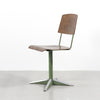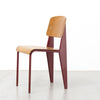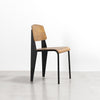Jean Prouvé
Designer
Jean Prouvé was born in Nancy, France in 1901, where he died in 1984. He is widely acknowledged as one of the twentieth century's most important and influential designers whose wide-ranging oeuvre combined bold elegance with economy of means and strong social conscience. Working as a craftsman, designer, manufacturer, architect, teacher, and engineer, his career spanned more than sixty years, during which time he produced prefabricated houses, building components and facades, as well as furniture for the home, office and school. Prouvé has played a pivotal role in the development of cutting-edge technology and modular systems for mass production in the post-war modernist period. Prouvé trained as an artisan blacksmith and his intimate knowledge of metal remained the foundation of his work and career. Aware of the limitations of ornamental and wrought-iron work and keen to embrace the modern movement, he moved on to steel and aluminum, folding and arc-welding. In 1931 he established the Atelier Jean Prouvé, where he began to produce light-weight metal furniture of his own design, as well as collaborating with some of the best-known designers of his time, including Le Corbusier and Charlotte Perriand. Furniture production became a core part of his business. He favored the public sector in the growing areas of health, education and administration, which reflected a social ideal but also offered the economies of scale. By 1936 he was producing a catalogue of standard models for hospitals, schools and offices. The potential for mass production inspired Prouvé to develop and patent industrial products using folded sheet metal for the construction of buildings. These included movable partitioning, metal doors and elevator cages. The onset of WWII and the age of austerity that followed marked a period of enforced experiment for Prouvé and in 1947 he moved his operations to Maxéville, just outside Nancy. With his own design studio, he could combine research, prototype development and production. At Maxéville he set about fulfilling his ambitious plan to alter the building process from a craft-based practice to that of a mechanized industry, producing not only houses, prefabricated huts, doors, windows, roof elements and façade panels but also a production line for furniture based on his own designs. It was in this creative environment that the prefabricated refugee houses of 1945 were developed, followed by the flat-packed, tropical houses for Niger and the Republic of Congo in 1949 and 1950. His work is included in private and public collections worldwide, including Centre Georges Pompidou, Paris and Museum of Modern Art, New York. Major exhibitions include “Jean Prouvé: Constructeur, 1901–1984,” Centre Georges Pompidou, Paris (1990–91); “Jean Prouvé: Three Nomadic Structures,” Pacific Design Center, Museum of Contemporary Art, Los Angeles (2005); “Jean Prouvé: A Tropical House,” Hammer Museum, Los Angeles (2006); “Jean Prouvé: The Poetics of the Technical Object,” Vitra Design Museum, Weil am Rhein, Germany (2006–07, traveled to Kamakura Museum of Modern Art; Deutsches Architekturmuseum, Frankfurt; Netherlands Architecture Institute, Maastricht; Hotel de Ville de Boulogne-Billancourt, Paris; Design Museum, London; and Museo dell'Ara Pacis, Rome, among other venues); “Ateliers Jean Prouvé,” Museum of Modern Art, New York (2008-09); a multi-exhibition, multi-venue tribute at Musée des beaux-arts, Nancy, France (2012); and “A Passion for Jean Prouvé: From Furniture to Architecture,” Pinacoteca Agnelli, Turin (2013).
Exhibited at Design Miami/ Basel 2023 Direction no. 353 swivelling office chair, 1951 Materials : Bent sheet steel, steel tube, sheet aluminum "diamond point" motif, leather and wood The principle of the swivel seat—for chairs and office chairs—was adopted in 1944, to complement the office models created during the War. Initially made in only a few examples, this first model was later marketed as FP 11, after modifications aimed at improving the rigidity of the frame. In 1951 the Direction no. 353 swivelling office chair replaced the FP 11, with a few details changed to improve comfort and finish. The bent steel of the feet was protected with stainless steel or diamond-point aluminum sheet, and was either encircled by an aluminum tube or fitted with casters. The padding was covered with fabric, leather or leatherette. Often associated with the Présidence desk, the Direction no. 353 swivelling chair was successfully marketed—then made— by Steph Simon until the late 1950s.






